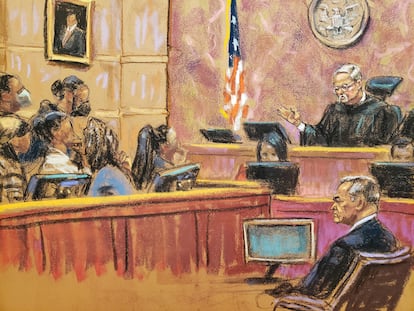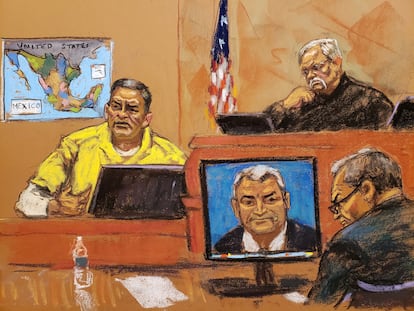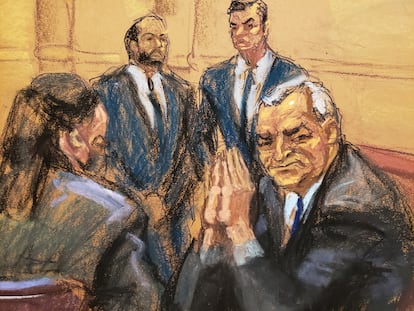Jury begins deliberations in Garcia Luna trial
Twelve New York citizens must reach a unanimous verdict on each of the five charges against the former Secretary of Public Safety

Deliberations have begun in the trial against Genaro García Luna. The members of the jury, 12 ordinary citizens of New York, will have to agree on the guilt or innocence of former Mexican president Felipe Calderón’s public security chief. The members must reach a unanimous decision on each of the five charges against the former official: three for cocaine trafficking, one for organized crime and one for providing false testimony. “This is one of the greatest responsibilities you will have in your lives,” Judge Brian Cogan said Thursday after instructing jurors on how they should deliver their verdict. Jury sessions are private and the decision can be released at any time upon notice to Cogan.
Up until this point, the jurors had not been allowed to discuss any details about the trial among each other. Now, the members are completely cut off from the outside world. A guard was sworn in at the end of the last session: he is to ensure that they do not talk to anyone on the outside, that they do not use any electronic devices, and he is to bring them their food. He is now their only point of contact. He will also help them send notes to Judge Cogan to make requests for the documents and other materials they might need to reach their decision. In an alternate courtroom, six substitutes are in virtually the same conditions, with the only difference being that they cannot comment on the judicial process. They will only come in as replacements in exceptional circumstances.
García Luna’s conspiracies
Judge Cogan explained to the jurors what they have to do, step by step. Unlike in other countries, in the US judges in jury trials serve an administrative function. It is the citizens who decide on whether the accused is guilty, and months later, the judge hands down a sentence. “You are the sole judges of the facts presented to you,” he reminded them. “You should be the ones wearing black robes,” he joked.
The judge condensed a course in US criminal law into just over two hours. He told the jury about the presumption of innocence. He reminded them that the burden of proof was on the prosecution, that it was up to them to prove that the defendant was guilty beyond a reasonable doubt, “a doubt based on reason and common sense.” He explained that they could only take into account testimony and evidence. And, he asked them not to be guided by any kind of prejudice or element outside of what they had seen in the past four weeks.
He also spoke about the charges put forth and how they should be decided. This is the highest profile trial of a former Mexican official in the United States and a direct consequence of him being tried in the US system in the first place is the type of crimes he is accused of. The indictment against Garcia Luna is based on the three drug trafficking charges. The exact names of these charges are: conspiracy to distribute cocaine internationally, conspiracy to distribute and possess cocaine, and conspiracy to import cocaine.
“In many countries this figure doesn’t exist, conspiracies are a very American crime,” noted former prosecutor Daniel Richman, a Columbia University law professor, in an interview with EL PAÍS last week. Cogan explained that a conspiracy is “an agreement between two people to do something illegal.” In the United States, this is a crime even if the plan fails or even if the crime is not committed. In Mexico, in contrast, there is no such thing as a “conspiracy” in legal terms.
In order to prove a conspiracy, the judge said, two things must be established. First, it must be demonstrated that “the conspiracy exists,” that is, that two or more people agreed to plan the crime. This can be explicit or by a “mutual understanding” or by something inferred from the physical evidence and testimony presented by prosecutors. “Actions speak louder than words,” said Cogan.
Secondly, it must be shown that the defendant participated in the conspiracy “knowingly and intentionally.” This means “with knowledge that what he was doing was wrong and with the intent to carry out the crime.” For example, García Luna was accused of aiding the Sinaloa Cartel in exchange for bribes. Incredible as it may seem, the prosecution had to prove that the Sinaloa Cartel existed and that one of its activities was cocaine trafficking. In between, it also had to prove that the defendant was part of the conspiracy: that he knew the cartel was involved in drug trafficking and still decided to get involved with them.
The three drug trafficking charges are for conspiracies to traffic cocaine, but not for cocaine trafficking as such. In the United States, charging someone with conspiracy to distribute drugs does not require that the defendant be caught uploading the packages or getting his hands on the merchandise. Rather, it is the agreement to do so that is being prosecuted. These were some of the points Cogan explained to the jury in order to reach their verdict, but in much more specific and, at times, difficult to understand terms.
Each crime has narrowly defined requirements of proof, detailed down to the millimeter. The same goes for each of the conspiracies, which have to be tried separately, and the other two counts: organized crime - being part of a continuing criminal enterprise - and making false statements on his naturalization application by stating that he had committed no crime. Those last two offenses are somewhat dependent on the other three drug trafficking offenses, Cogan pointed out. On top of that, there are aggravating factors and specific defense motions to consider as well.
Despite all these technical details, the verdict rests solely with the jury and opens the door to many possible outcomes. García Luna could be found guilty of all the crimes or acquitted of everything he is charged with. But he could also be convicted of two or three or four charges and be found not guilty of the rest. If ultimately there is no unanimous agreement among the jurors, the trial could be declared a mistrial. Therefore, it is common for jurors to take enough time to reach a minimum agreement among themselves and try to avoid that scenario whenever possible. The fate of the former Mexican official is in the hands of 12 New Yorkers.
Sign up for our weekly newsletter to get more English-language news coverage from EL PAÍS USA Edition
Tu suscripción se está usando en otro dispositivo
¿Quieres añadir otro usuario a tu suscripción?
Si continúas leyendo en este dispositivo, no se podrá leer en el otro.
FlechaTu suscripción se está usando en otro dispositivo y solo puedes acceder a EL PAÍS desde un dispositivo a la vez.
Si quieres compartir tu cuenta, cambia tu suscripción a la modalidad Premium, así podrás añadir otro usuario. Cada uno accederá con su propia cuenta de email, lo que os permitirá personalizar vuestra experiencia en EL PAÍS.
¿Tienes una suscripción de empresa? Accede aquí para contratar más cuentas.
En el caso de no saber quién está usando tu cuenta, te recomendamos cambiar tu contraseña aquí.
Si decides continuar compartiendo tu cuenta, este mensaje se mostrará en tu dispositivo y en el de la otra persona que está usando tu cuenta de forma indefinida, afectando a tu experiencia de lectura. Puedes consultar aquí los términos y condiciones de la suscripción digital.
More information
Archived In
Últimas noticias
Welcome to the post-religion era: The idea of Christianity as the absolute truth has become obsolete
‘I thought you would like it’: The risky sexual practice popularized by TV shows and TikTok
The digitalization of tourism: ‘They promise experiences and gave us the worst possible one’
Mexican peso defies uncertainty with forecasts of a new period of stability in 2026
Most viewed
- Sinaloa Cartel war is taking its toll on Los Chapitos
- Oona Chaplin: ‘I told James Cameron that I was living in a treehouse and starting a permaculture project with a friend’
- Reinhard Genzel, Nobel laureate in physics: ‘One-minute videos will never give you the truth’
- Why the price of coffee has skyrocketed: from Brazilian plantations to specialty coffee houses
- Silver prices are going crazy: This is what’s fueling the rally











































